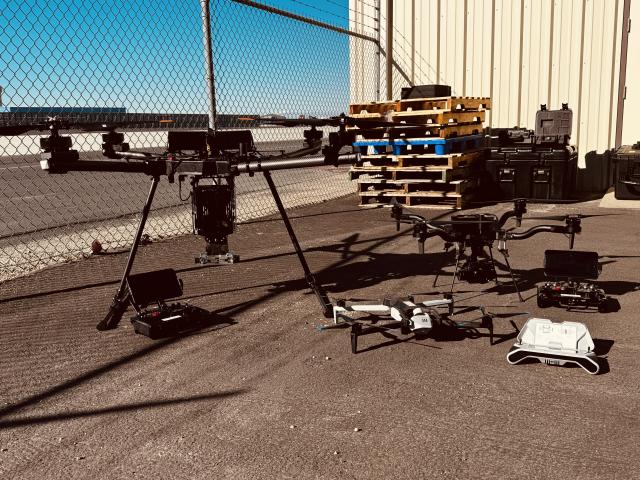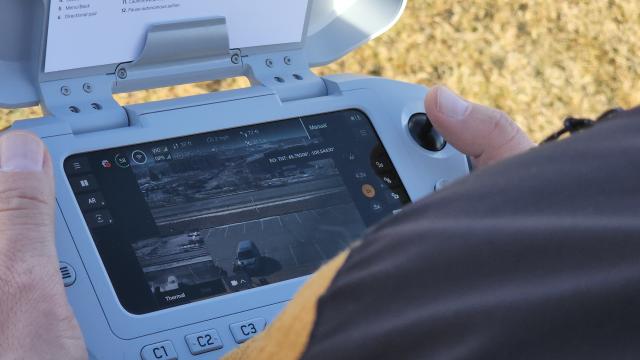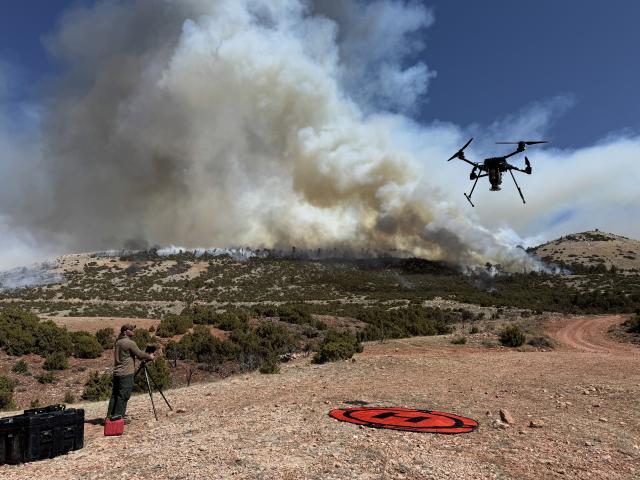Uncrewed aircraft reduce cost, lower risk, and improve land management
The Bureau of Land Management oversees millions of acres of public lands across the country, and uncrewed aircraft are one of our important tools. These aircraft support a wide range of field operations, from managing wildfires and protecting wildlife to documenting historic sites and supporting law enforcement. By providing a safer, faster way to collect detailed information, especially in rugged or hazardous terrain, uncrewed systems allow BLM employees to do their important work more effectively and with less risk.
Currently, BLM uses two types of uncrewed aircraft. The Freefly Alta X is larger and used for heavier tasks, like carrying tools to ignite controlled burns from the air. Other aircraft are small enough to fit in a backpack and account for more than 80% of BLM’s uncrewed flights. These include the Freefly Astro and Skydio X10, which capture video, thermal images, and data that can create products like maps and 3D models.

“Uncrewed aircraft are a force multiplier. Our community of remote pilots works closely internally and across agency boundaries to accomplish work efficiently,” said BLM’s National Aviation Program Manager Matt Dutton at the National Interagency Fire Center in Boise, Idaho. “A project that could take weeks or months to accomplish traditionally, can now be done in hours or days. That’s exciting!”
There are currently 65 uncrewed aircraft pilots and 75 aircraft in the bureau’s fleet working on projects across the nation.

From coastlines to wildfire zones, BLM teams are putting these aircraft to work in creative and practical ways. Here’s a closer look at how we use them in the field:
- Along the Oregon coast, the New River changes course often, which can cause flooding. BLM uses uncrewed aircraft to monitor the river and help decide if action is needed to protect nearby cranberry farms and wildlife habitats. These flights are safer, faster, and provide more useful data than hiking the area on foot.
- Following the 2023 Anvil Fire, uncrewed aircraft support post-fire rehabilitation efforts. Operating in steep, unstable terrain, the aircraft capture imagery that help monitor tree health, assess burn severity, and develop replanting strategies without risk to ground personnel.
- Our abandoned mine experts use uncrewed aircraft to safely inspect and document old mining sites. In one 2024 project, aircraft collected more than 660GB of data at two sites in Oregon. These detailed maps help BLM understand the condition of each site and plan for clean-up or repairs more effectively.
- BLM Law Enforcement is also putting uncrewed aircraft to use in both planned and emergency situations, from processing crime scenes and patrolling remote border areas to responding to search and rescue calls. On May 7, 2025, Southern Nevada District Rangers used an uncrewed aircraft to locate and assist a lost individual in a steep canyon at night in Red Rock Canyon National Conservation Area. With the help of thermal imaging and navigation strobes, the aircraft located the person and guided him safely back to waiting responders. The pilot flew the Skydio X10-Z, which BLM Law Enforcement now uses nationwide.
- BLM Fire crews use uncrewed aircraft to scout wildfires, create maps, and drop small ignition devices to start controlled burns, reducing dangerous fuel buildup. Using uncrewed systems instead of piloted aircraft lowers firefighter risk and cost. Upcoming uncrewed aircraft-supported burns are planned across Colorado, Montana, Oregon, and Wyoming in 2025.

Uncrewed aircraft help BLM work smarter and safer on public lands. They provide vital information, while keeping staff out of harm’s way during fires, search operations, or environmental studies. However, unauthorized aircraft flown by the public during these operations can pose serious risks and bring critical missions to a stop.
Federal, state, and local wildland fire management agencies, along with the Federal Aviation Administration, urge the public never to fly uncrewed aircraft over or near wildfires. If the public flies, BLM cannot. For more information, visit Know Before You Fly, an educational campaign that offers important guidance on how to fly safely and responsibly.
As aircraft technology continues to advance, BLM is committed to expanding use of uncrewed systems to enhance safety, efficiency, and innovation in managing America’s public lands. By combining cutting-edge tools with the expertise of its dedicated staff, the agency is better equipped than ever to protect natural resources, respond to emergencies and serve the public for generations to come.
Sarah Holm, Public Affairs Specialist
Related Stories
- “Where did my horse come from?” BLM launches a new way for adopters, trainers and others to learn about their wild horses and burros
- Helping Woodlands & Fighting Fire with the Dawson Project
- Lake Havasu Fisheries Improvement Program is the gift that keeps giving
- BLM is thankful for public lands volunteers
- BLM Fire and National Conservation Lands managers collaborate to meet shared goals
